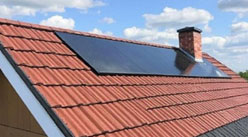
Different parts of the roof structure of a building

The roof is the upper covering of the building or the shelter which helps to protect the building from outside elements and thus helps to contribute to the security, safety, insulation and privacy of the building structure. The roof structure of a building also serves as a barrier against different kinds of weather conditions. The roof structure also features windows for lights, ventilation, access or views. Several additional elements including communication infrastructure, chimneys, drainage system, lighting and others can also be incorporated into the roof structure.

Different parts of the roof structure of a building
The parts of the roof structure have been categorised into four categories which are structural elements, ventilation, drainage components, and exterior components. The functions of each part of the roof influence the integrity of the building structure.
Structural elements of the roof
The structural parts of the roof are the base which helps to support the roof. These structural parts help to provide stability and slope which helps to stand up against the building elements. The structural parts of the roof include:
Trusses or Rafters
This part is usually made of wood which is typically angled for providing a slope to the roof. This part is the main support for the roof structure of a building.

Roof Decking
This part of the roof is also known as the sheathing which has been attached to the outside of the rafters. The plywood or a composite has been used to make this roof part. This roof deck helps to provide the base for shingles as well as protective layers underneath them.

Collar Beams
Collar beams are used in those areas where high winds or frequent storms have occurred. This part helps to provide more stability to the roof structure.

Drainage component of the roof
This part of the roof helps to allow the water to run off the roof thus helping to stop damage caused by water. An adequate drainage system is critical for a roof structure which can be done by:
Flashing
This metal part helps to protect the areas around the roof elements including vents and chimneys as well as this part helps to stop water that entering from the gaps around these components.

Drip Edge Flashing
This part helps to direct water into the gutter as well as helps to keep moisture from seeping back into the decking.

Underlayment
This is the solid and water-repellent barrier which helps to cover the roof decking. This part helps to stop water from damaging the structural parts of the roof causing leaks inside the building.

Gutters
This part has been attached to the edge of the roof which helps to collect water and directs the water to the downspouts thus carrying it away from the house. To avoid runoff pooling around the foundation of the home that causes foundation damage or flooding, gutters are necessary.

Ventilation
This roof part helps to allow the outside air to enter into the building structure as well as expelling hot and moist air from the attic. The active vents rely on fans which help to draw air into the room or push out moist air, whereas, the passive vent relies on the natural airflow which helps to push air through the attic.

Exterior components of the roof
These exterior parts are the visible parts of the roofs which act as the last layer of protection between the climate and the building. Some examples of exterior elements are:
Ridge Cap
This part has been made from metal which sits on the top of the roof and protects the space in which two slopes of the roof are met. Thai part helps to prevent the chances of leaks or ice build-up on the roof.

Roof Covering
This part is usually made from composite materials and asphalt which help to cover the roof deck and underlayment. This roof covering helps to protect the roof from the reflected sunlight and inclement weather.

Valley
This is the intersection of two sides of the roof structure which is covered by the ridge cap. In the case of the roof having more than two sides, the topmost area of the roof is known as the hip.

Fascia
This part is the narrow metal, wood or composite strip which helps to cover the edge of the roof.
Soffit
This part is present at the bottom of the roof overhang which helps to protect the overhang from the elements.

To learn more, watch the following video tutorial.
Video Source: BRUNI ARCHITECTURE
Eaves
This part helps to extend beyond the walls of the building as well as helps to keep the water from getting into the foundation and the wall.

The construction process of the roof structure

The construction of the roof structure of the building has been done in several steps which are as follows:
➢ At first, the construction of the column, beam and walls should begin to construct the roof structure.
➢ The next step is working on the shuttering for the roof which has been made of steel of wood. The scaffolding blocks or bamboo are used to provide support so that the shuttering does not collapse under the slab’s weight.
➢ The next step is placing the mesh of steel bars on the above slab. The cover blocks have been placed below the steel rods which can be fixed in the position of the bars.
➢ Then, a concrete mix was made with the help of the cement, sand and aggregates in which a waterproofing compound Weather Pro was also mixed.
➢ After preparing the concrete mix, the concrete was applied, levelled well and waited until the concrete got compacted.
➢ After that, a small pond has been constructed to cure the slab. This curing process should have to be completed within 2-3 weeks. After strengthening the slab, the shuttering can be removed carefully and thus the entire roof structure has been constructed.


